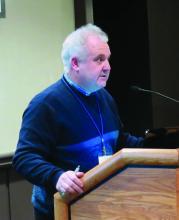MONTREAL – Does rurality matter in cancer treatment? According to lessons from a Scottish study, the answer may be yes, but in unexpected ways.
Patients who lived further away from a cancer treatment center were more likely to be treated within the 62 days postreferral window that the Scottish government has set as a target. Compared with those living within 15 minutes of a cancer center, the adjusted odds ratio for patients living at least an hour away to receive timely treatment was 1.42 (95% confidence interval, 1.25-1.61). For those living on remote islands, the aOR was 1.32 (95% CI, 1.09-1.59).
However, those living farther away were less likely to be alive 1 year after survival, pointing to yet-unexplained factors that may impede ongoing cancer treatment and how complications are dealt with among rural-dwelling cancer patients, said Peter Murchie, MB ChB, PhD, of the University of Aberdeen in Scotland.Dr. Murchie, speaking at the annual meeting of the North American Primary Care Research Group, shared results of an updated study that looked at the cancer population in Northeast Scotland to see how living farther from a cancer center might be associated with time to diagnosis and treatment of cancer and with 1-year survival rates.
A “seminal” work that set the background for this study, said Dr. Murchie, was the 2002 publication tracking the relationship between rural residence status and cancer survival (Br J Cancer. 2002;87[6]:585-90). Findings from that study showed that as the distance from the patient’s residence to a cancer center increased, so did the risk that the cancer wasn’t diagnosed before death. Survival, especially for prostate and lung cancer, was found to decrease with increasing distance, said Dr. Murchie.
“This study has been widely replicated in the global literature, but the mechanisms have never been satisfactorily explained,” he said.
For the present study, the primary outcome measure was whether patients achieved treatment within 62 days of referral, the target set by the Scottish government, said Dr. Murchie.
Secondary outcomes included secondary care delay – whether treatment was begun within 31 days of diagnosis – and survival at 1 year after presentation or referral by a general practitioner.
A total of 12,339 patients were included; 74% were older than 60 years. Patients were relatively affluent, with 59% in the two least-deprived quintiles according to Scottish government classification. Dr. Murchie said that this is in keeping with the geographic-socioeconomic status distribution in Scotland. Females made up 56% of the population, and 35% were classified as rural dwelling.
Nearly a third of patients (n = 3,722; 30.6%) had breast cancer. Colorectal cancer was the next most common diagnosis (n = 2,775; 22.5%), followed by prostate cancer, lung cancer, upper gastrointestinal cancer, melanoma, and cervical cancer. Most patients (n = 8,537; 62%) had a Charlson Comorbidity Index score of 0.
Dr. Murchie used the Northeast and Aberdeen Scottish Cancer and Residence Cohort (NASCAR) data gathered during 2007-2014; the cohort’s data came from a variety of sources, including the region’s cancer care pathway database. National cancer registries, morbidity records, and other nationally maintained demographic databases were also used for the NASCAR dataset.
Those building the NASCAR cohort were able to link all of the data from disparate datasets and still keep investigators blinded to patient identity via a “safe harvest” technique that created pseudonyms to harmonize the datasets.
Using patient postal codes, a geographical information systems approach was used to determine traveling time to a cancer center. Travel time, Dr. Murchie pointed out, is a better measure than straight-line distance of true accessibility for rural-dwelling patients.
In discussion, Dr. Murchie said that the correlation between longer distance and shorter time to treatment held even when he and his colleagues controlled for “the most obvious explanation – that disease was more advanced on diagnosis among remoter people.” But, he said, “This does not translate into better survival. Why?”
Hypotheses, said Dr. Murchie, include the many small and large barriers to care that rural-dwelling individuals face. They must find a way to their GP, or place a phone call, and that physician must weigh the risk of a serious complication against the burden to the patient – and that patient’s family – of travel from a remote location to a cancer center.
Dr. Murchie encouraged international collaboration and replication of his work so that cancer researchers and primary care practitioners can reach a better understanding of the unique challenges in treating rural cancer patients.
Dr. Murchie reported that he had no relevant disclosures.


